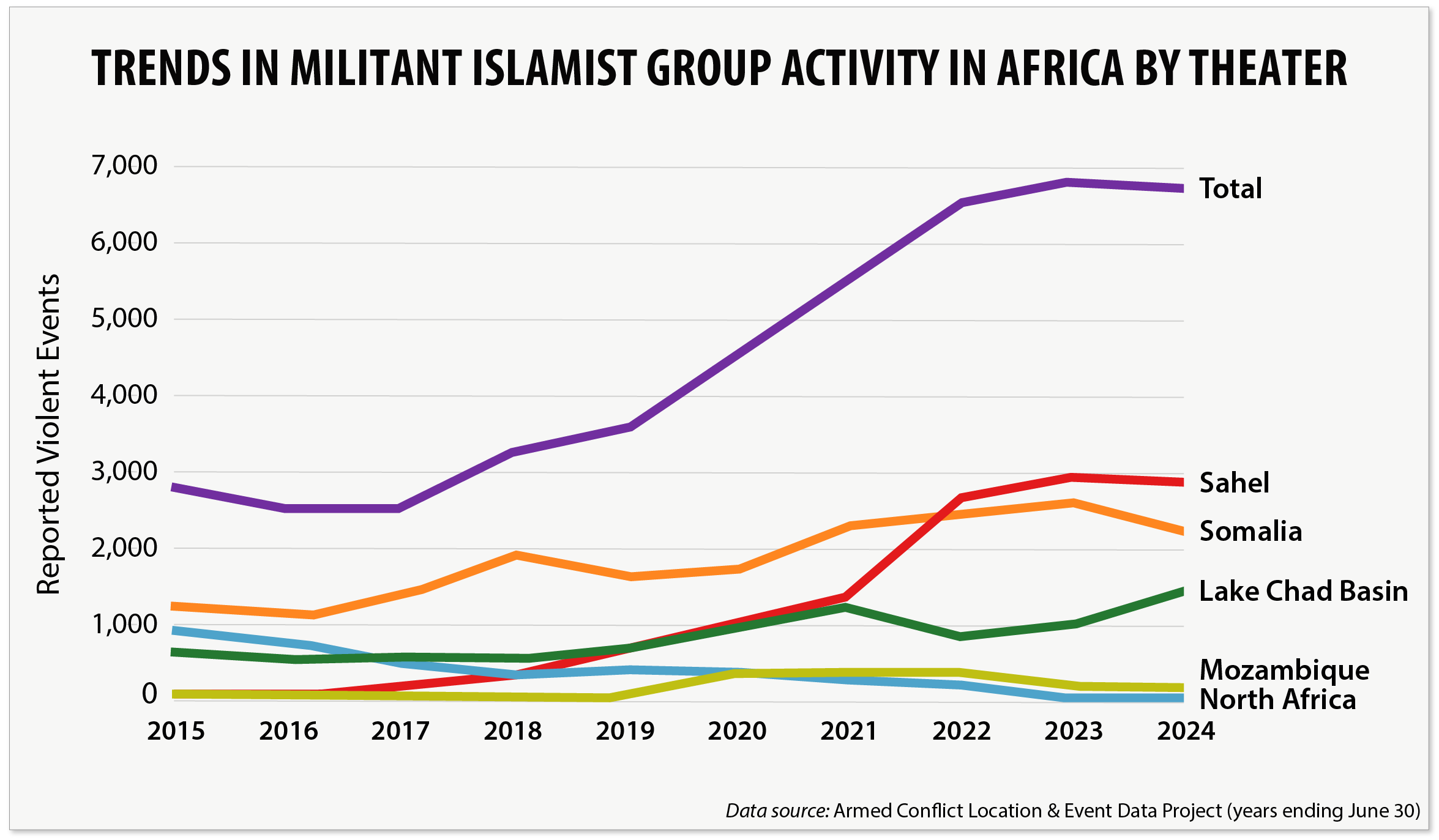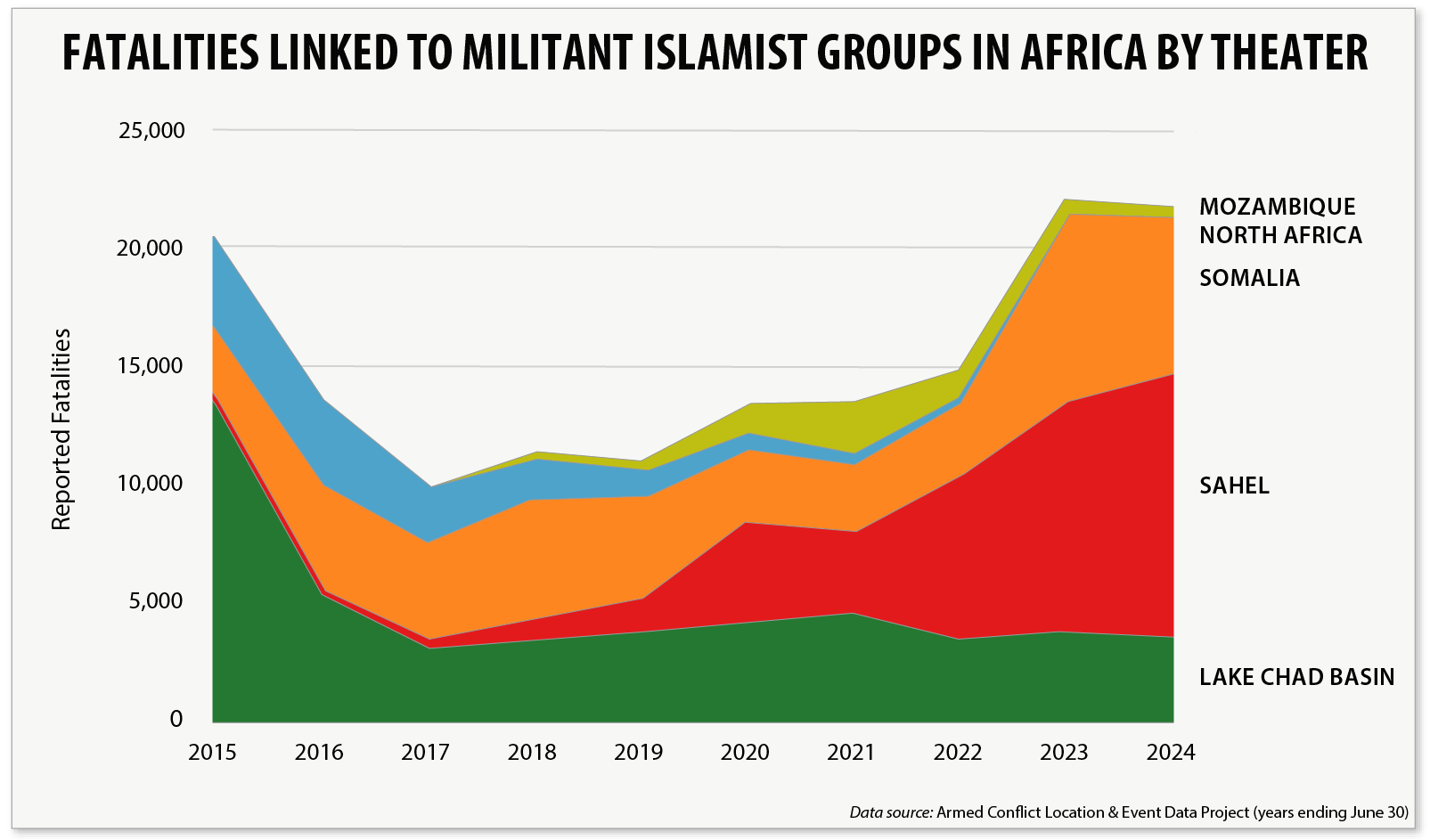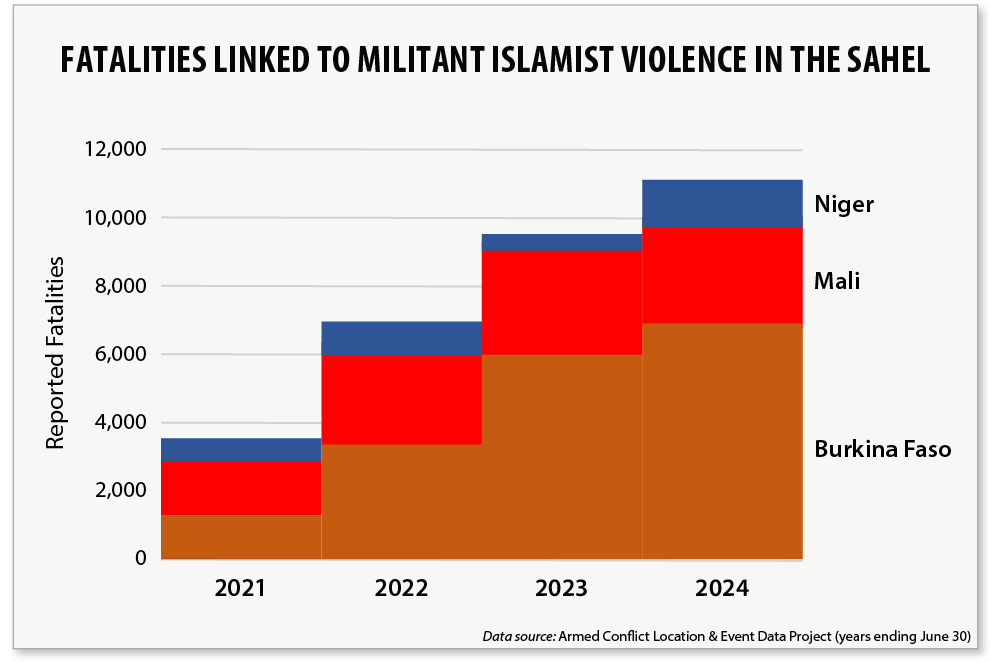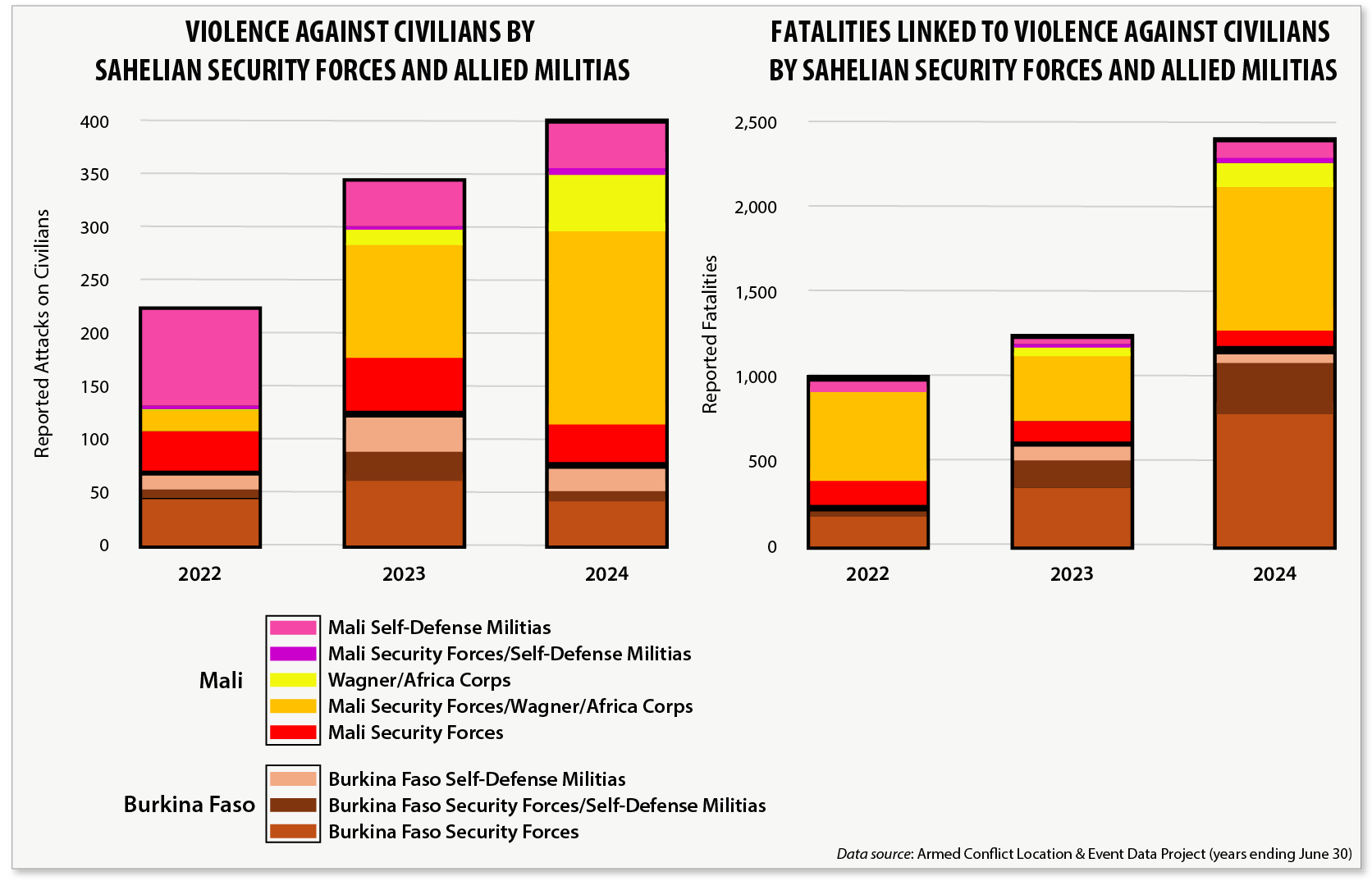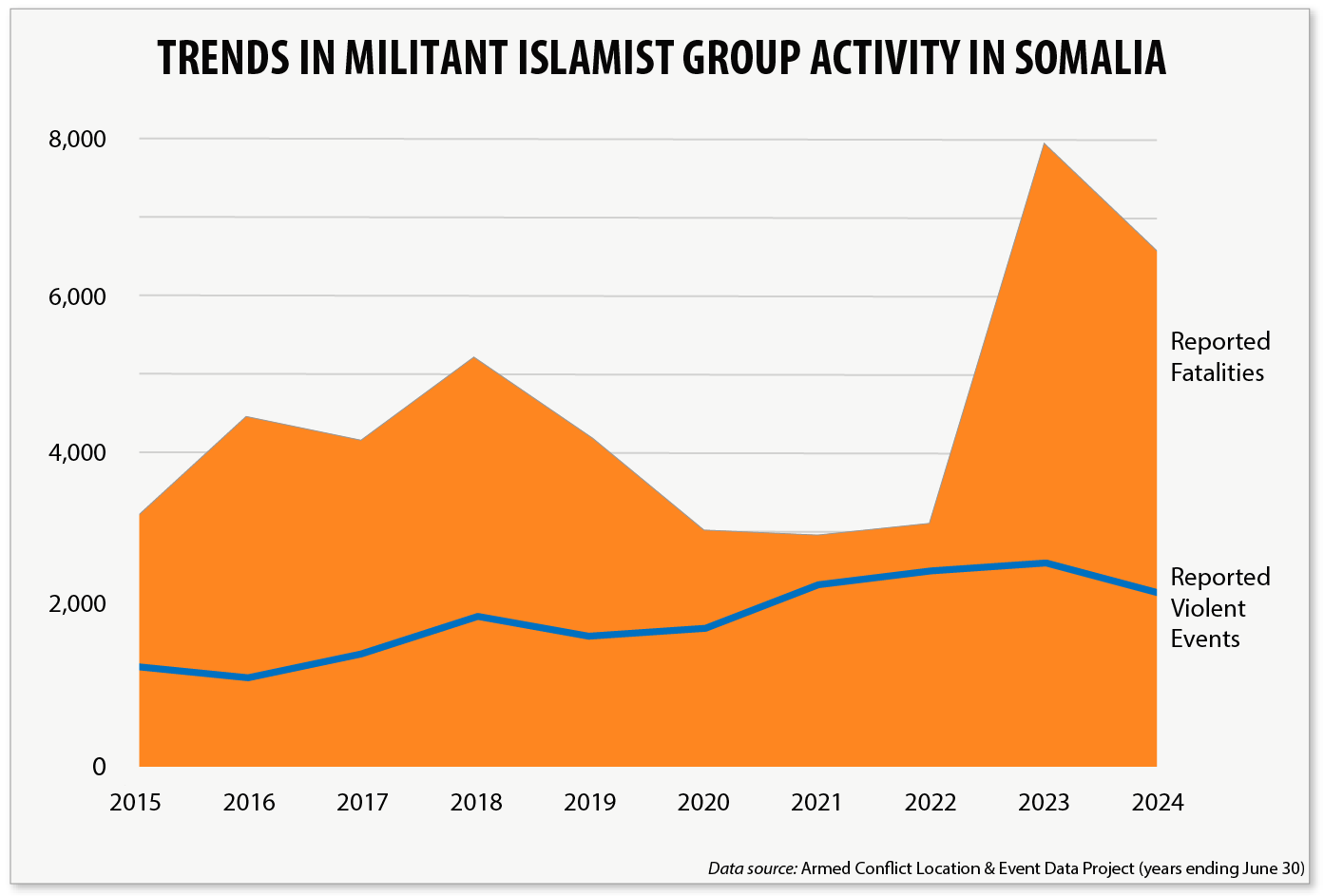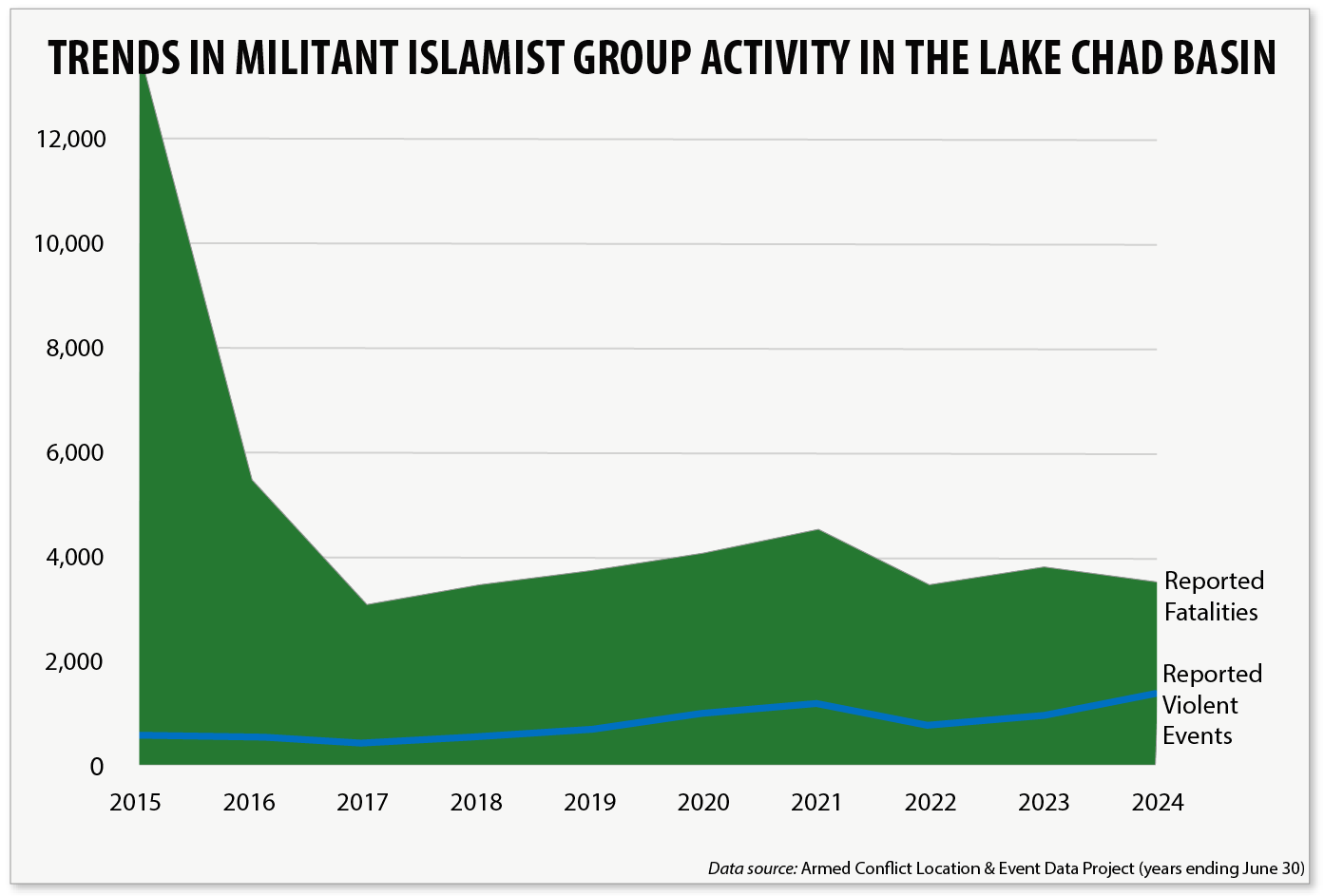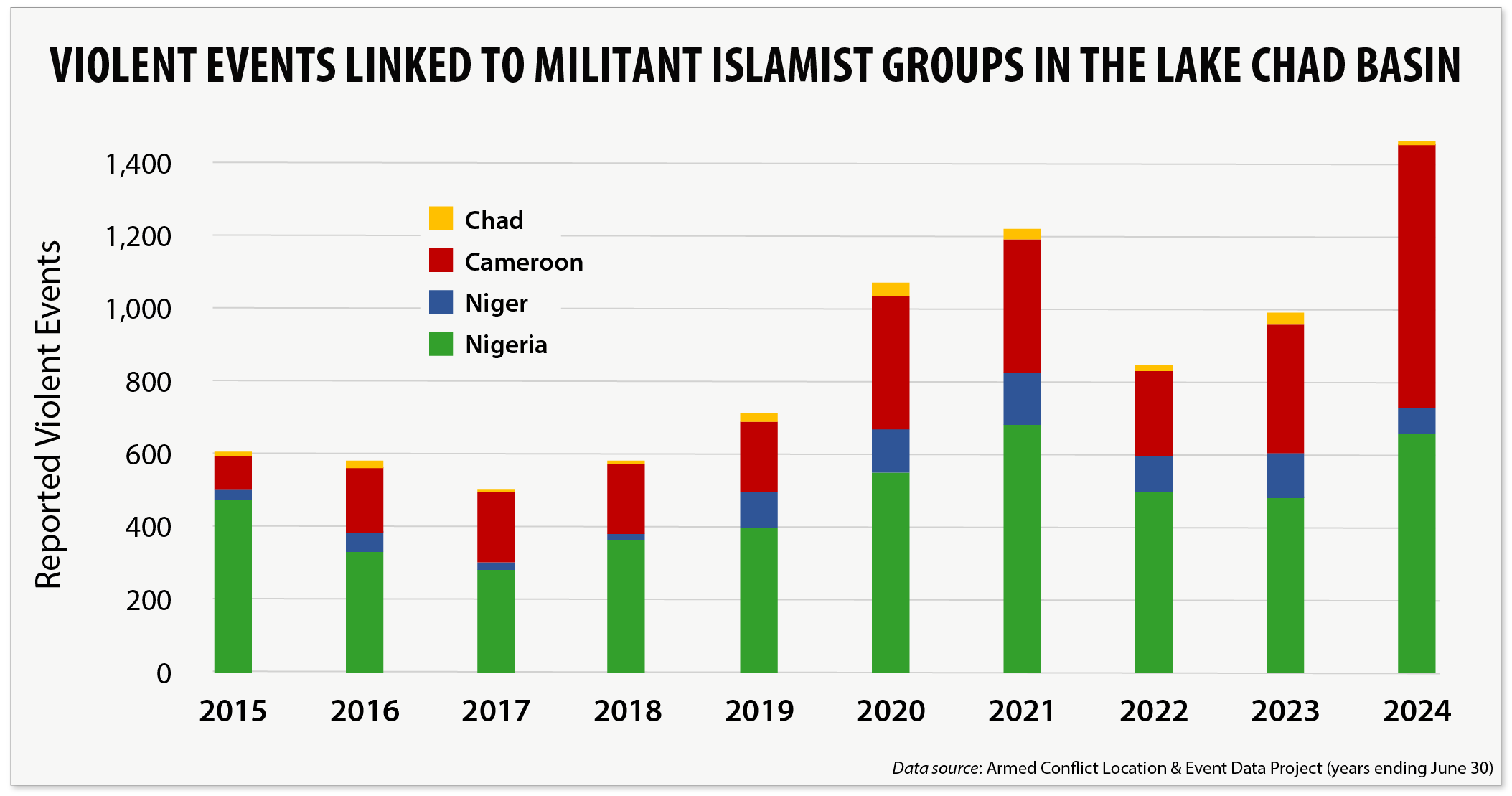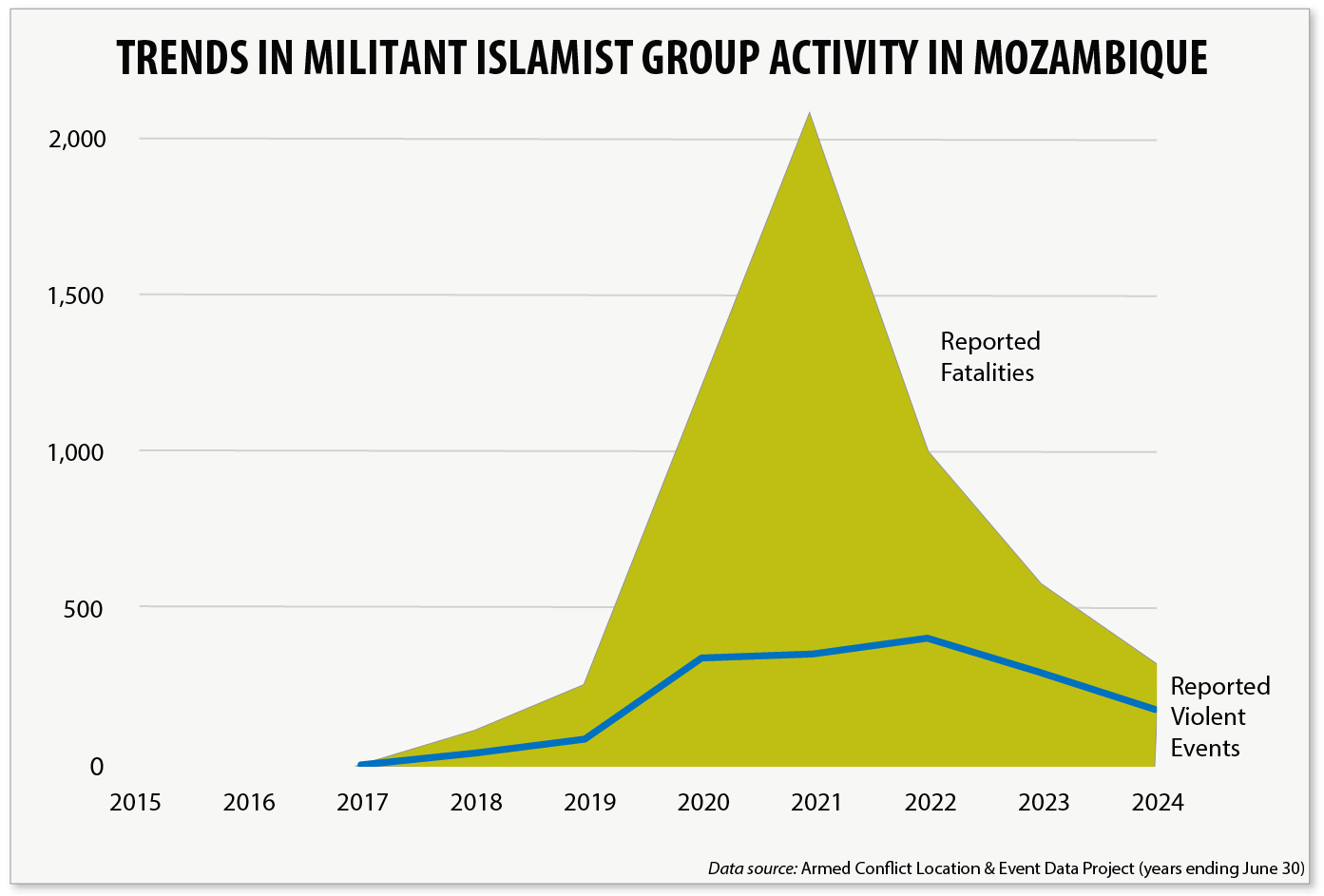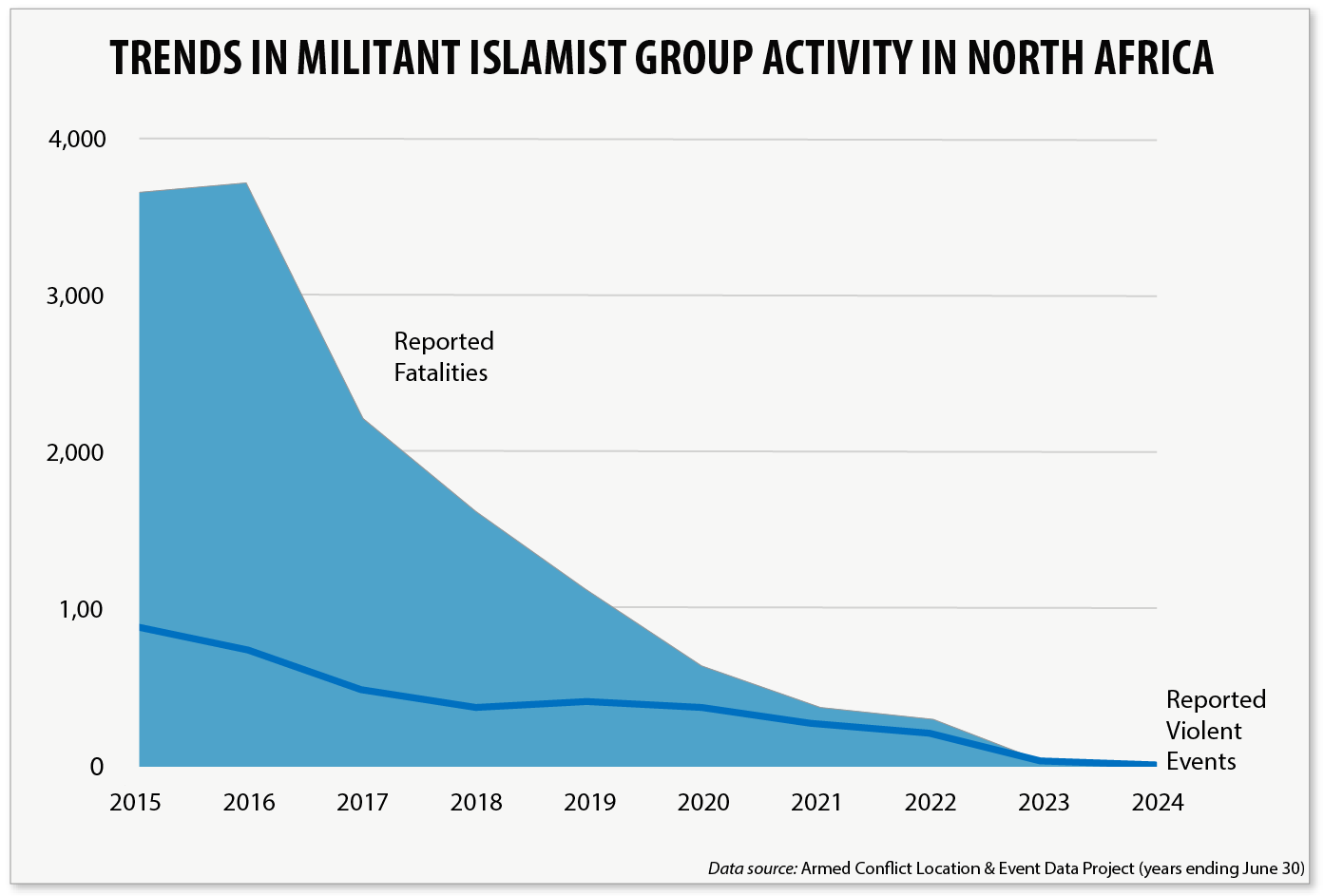Highlights
The threat from militant Islamist groups in Africa over the past decade has steadily grown—with almost three times the number of annual violent events (roughly 6,700) as in 2014. The reported 21,780 annual fatalities represent a 56-percent increase just from 2021.
These topline figures obscure the great variability seen between and within each region over this time. This underscores the distinct local features—leadership and organizational structures, community and government responses, and external actors—that are driving this violence.
The 11,200 deaths in the Sahel in 2024—a tripling since 2021—now represent over half of all reported fatalities across the continent.
A decade ago, the Lake Chad Basin was the focal point of the violent extremist threat, comprising 13,670 annual fatalities—67 percent of the reported fatalities across the continent. North Africa was second, with 3,650 fatalities. Today, annual deaths in the Lake Chad Basin have declined almost fourfold from that high-water mark (though still above 3,600) while North Africa has the least reported fatalities of any of the five active regions.
A decade ago, the Sahel was the region facing the fewest deaths linked to violent extremism. Today it is the region with the most, a distinction it has held for the past 3 years. The 11,200 deaths in the Sahel in 2024—a tripling since 2021—now represent over half of all reported fatalities across the continent. This does not include the roughly 2,430 civilian deaths attributed to the Sahelian militaries and Russian forces (ostensibly in the name of countering violent extremism)—which is more than the number of civilians killed by the theater’s militant Islamist groups.
Somalia has arguably faced the most consistently serious violent extremist threat on the continent over the past decade. It regularly experienced high, if not the highest, number of militant Islamist-linked violent events and fatalities. Today, the Sahel and Somalia account for over 80 percent of all violent extremist fatalities on the continent.
A decade ago, there were just four theaters of militant Islamist violence—Somalia and the Sahel joining the Lake Chad Basin and North Africa. At the end of 2017, a fifth region was added—with militant Islamist violence taking hold in northern Mozambique. This underscores that violent extremism in Africa is concentrated in specific regions—rather than being a uniform threat across the continent.
These dramatic fluctuations over the past decade underscore how dynamics can and do change across and within each of these theaters. Progress can be achieved—yet militant Islamist groups have demonstrated remarkable adaptability and resilience. This reinforces the importance of understanding the unique drivers and sustaining context-specific responses in each region.
- More than half of all annual reported fatalities (11,200) involving militant Islamist groups in Africa are in the Sahel. The Sahel has accounted for more fatalities than any other region on the continent since 2021.
- Burkina Faso bears the majority of violent events (48 percent) and fatalities (62 percent) linked to militant Islamist groups in the Sahelian theater.
- The Sahelian theater has been experiencing an increasing number of attacks on civilians. For the last 3 years, the Sahel has accounted for more than half the reported attacks on civilians by militant Islamist groups in Africa.
- The level of violence in the Sahel is likely even higher. Following the coups in Mali (2020 and 2021), Burkina Faso (two in 2022), and Niger (2023), there has been a concerted effort to muzzle domestic media and the international press. As a result, there is diminishing access to accurate information on violent events in the region.
- Non-coincidentally, there has been an escalation of violence against civilians by the junta’s security forces and their paramilitary partners (including Russia’s Africa Corps, formerly the Wagner Group). The number of attacks against civilians by these security actors has increased 76 percent between 2022 and 2024 (from roughly 230 to 400 attacks). Over the last 3 years, an estimated 4,740 civilians have been killed by these forces.
- Security force violence against civilians has consistently been found to propel recruitment by violent extremist groups.
- The Sahelian military juntas and their militia allies have killed more civilians (2,430) in the past year than militant Islamist groups (2,050).
- Other tangible evidence of the worsening security situation in the Sahel is seen in the rise in numbers of violent extremist attacks in the southern regions of Mali and Burkina Faso. The spillover from this escalation in the Sahelian countries is being felt in coastal West Africa where there have been over 500 violent extremist events in or within 50 km of their borders in the past 12 months. This compares to just over 50 such events in 2020. In 2024, violent extremist attacks in Benin and Togo comprised 7 percent of the reported violent events in this theater.
The Sahelian military juntas and their militia allies have killed more civilians (2,430) in the past year than militant Islamist groups (2,050).
- Ambushes of security forces in the Sahelian countries have also been on the rise in recent years. In 2021, there were 10 reported violent extremist attacks that resulted in 10 or more fatalities of members of the armed forces of Sahelian countries. By the end of 2024, this figure is projected to rise to 50.
Militant Islamist Group Ambushes on Security Forces in the Sahel
2021 | 2022 | 2023 | 2024 (projected) |
|
|---|---|---|---|---|
| Mali | 5 | 5 | 12 | 10 |
| Burkina Faso | 3 | 11 | 21 | 36 |
| Niger | 2 | 0 | 0 | 4 |
| Total | 10 | 16 | 33 | 50 |
Militant Islamist Group Ambushes on Security Forces in the Sahel
2021 | 2022 | 2023 | 2024 (projected) |
|
|---|---|---|---|---|
| Mali | 5 | 5 | 12 | 10 |
| Burkina Faso | 3 | 11 | 21 | 36 |
| Niger | 2 | 0 | 0 | 4 |
| Total | 10 | 16 | 33 | 50 |
- It is now estimated that 60 percent of Burkina Faso’s territory is outside the control of the military. In Mali, the figure is 50 percent, with parts of central and southern Mali falling out of state control in recent years. In 2021, territory outside of state control was estimated at 40 percent for each country. In Burkina Faso, up to 75 towns and cities are besieged by militant Islamist groups cutting their populations off from essential supplies.
- Due to the growing instability, the number of forcibly displaced people is also on the rise, including an estimated 3 million Burkinabe.
- Somalia is Africa’s most enduring theater of militant Islamist group activity having persisted for three decades. Today, Somalia accounts for roughly a third of all militant Islamist-related fatalities on the continent, making it the second most active theater (after the Sahel), which it has been for the past 3 years.
- Fatalities in Somalia in recent years have been approaching record levels for this theater. The 6,590 reported fatalities in 2024 are more than double that of 2020.
- This spike in fatalities is largely due to the government offensive against al Shabaab launched by President Hassan Sheikh Mohamud in 2022—and al Shabaab’s subsequent counter attacks—though these battles have diminished from their peak over the past year.
- Virtually all the reported events and fatalities in this theater are linked to al Shabaab. The Islamic State in Somalia (ISS) accounts for less than 1 percent of militant Islamist activity in Somalia and neighboring Kenya.
- A notable development in the Somalia theater in recent years is the increased use of drones and suicide bombings (i.e., remote violence), of which there were 640 incidents in the past year.
- Fatalities linked to al Shabaab’s use of remote violence (including 17 suicide bombings), have more than doubled since 2020, to 1,950 deaths.
- This theater has also seen a doubling in the number of violent events linked to al Shabaab in Kenya (to over 110 episodes and over 250 fatalities). Most of these are in the border areas. While these events represent just 5 percent of the total violent incidents in this theater, they are a reminder of the regional threat posed by al Shabaab.
- Militant Islamist violence in the Lake Chad Basin (comprising northeast Nigeria and the borderlands of Cameroon, Niger, and Chad) has ebbed and flowed over the past decade. The past 2 years have seen an increase in violent events after a period of decline. However, annual fatalities linked to these events have remained relatively consistent, typically ranging from 3,500 to 3,800 deaths. This has made the Lake Chad Basin the third most lethal region from militant Islamist violence on the continent—accounting for 17 percent of all fatalities.
- The persistence of the militant Islamist threat in the Lake Chad Basin points to the resilience and adaptability of Boko Haram and its offshoot, the Islamic State in West Africa (ISWA). A third group, Ansaru, comprises less than 1 percent of all reported violent events and fatalities in the theater.
- A notable development in this theater in recent years is the geographic expansion of militant Islamist violence into Cameroon. This year marks the first time Cameroon comprised over 50 percent of the events linked to militant Islamists in the theater. These 720 violent episodes represent a nearly threefold increase from 2022. Reported fatalities in Cameroon (780) have likewise doubled over this timespan.
- While Nigeria continues to bear the vast majority of militant Islamist-related deaths (72 percent), fatalities in Cameroon now represent 21 percent of the total in the theater.
- The past year has also seen a spike in militant Islamist-linked fatalities in Chad (on track for 180 deaths by the end of 2024) after a sharp decline in the preceding years.
- This shifting geographic pressure may reshape the regional security demands for this theater.
- Recent years have also seen a surge in militant Islamist violence against civilians and remote violence in the region. Violence against civilians comprised 41 percent of events in the region—a higher percentage than any other theater. These 590 episodes marked a doubling in the number of targeted attacks on civilians compared to 2022. The attacks on civilians reveal the lack of popular support for Boko Haram and ISWA—and the militant groups’ willingness to use violence to intimidate local populations.
- The increased attacks on civilians come as the Nigerian government has made significant gains against the extremists. Some 5,630 militant Islamists surrendered to Nigerian forces in 2024 adding to the tens of thousands who have laid down their arms since the government started an amnesty program for fighters in 2016.
Violence against civilians comprised 41 percent of events in the region—a higher percentage than any other theater.
- The fight against violent extremists in Nigeria’s North East region parallels a growing threat to civilians from organized criminal gangs in the North West region. Commonly known as “bandits,” these groups have engaged in looting, extortion, and kidnapping for ransom for financial gain. In fact, violence from these armed gangs in the North West has killed more civilians than Boko Haram and ISWA between 2018 and 2023.
- The persistence of the threat of these organized gangs increases the risk of cooperation with militant Islamist groups in the North East or with the violent extremists pushing down into southern Niger from the Sahel theater. Such convergence could dramatically amplify the security challenges for both theaters.
- Violence from militant Islamist actors in northern Mozambique has fluctuated dramatically since this threat first emerged in 2017. After escalating rapidly through 2021, which saw 2,080 deaths linked to violent extremist activity, northern Mozambique saw a nearly sixfold decline in deaths over the next 3 years. This decline is linked with the arrival of Southern African Development Community (SADC) and Rwandan security forces in July 2021.
- The past year has seen a rebounding of violent events and fatalities linked to the militant Islamists, however. The projected 250 events and 460 fatalities by the end of 2024 would represent a near doubling in violence over the previous year. This underscores the resiliency of these militant Islamist groups, which have moved inland from their previous concentration on the coast. It also highlights the importance of a sustained security and government presence to ensure these threats are permanently addressed.
The projected 250 events and 460 fatalities by the end of 2024 would represent a near doubling in violence over the previous year. This underscores the resiliency of these militant Islamist groups.
- Though SADC officially ended its mission in July 2024, Rwandan, South African, and Tanzanian forces have remained to assist in the stabilization efforts in this theater.
- The North African theater has seen a steady decline in violent events and fatalities linked to militant Islamist groups since 2015 when the region experienced over 3,650 related deaths. Further dramatic declines in recent years brought these fatality totals down to single digits.
- This year marks the first year there were no violent events linked to militant Islamist groups in Egypt since 2010.
- The 5 reported events over the past 12 months—4 in Algeria and 1 in Libya—were military operations targeting remnant members of Al Qaeda in the Islamic Maghreb (AQIM) and Islamic State in Libya (ISL). The steady decline in violence reflects a combination of factors, most notably the constant pressure from Egypt, Algeria, and Tunisia—and the lack of popular support for the extremists.
- In Libya, the United Nations believes ISL and al Qaeda still have fighters in the southern part of the country, though they appear to be focused on profiting from the illicit economy. This enduring threat underscores the importance of continued vigilance in this region.


